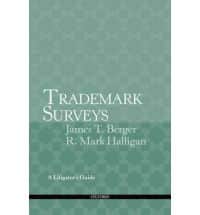“There are three kinds of lies: lies, damned lies, and statistics.” ~British Prime Minister Benjamin Disraeli
Surveys are everywhere and poll results are available for every imaginable topic. In the U.S., there were concerns about the admissibility of surveys for hearsay reasons but legislative amendment (Rule 702 of the 1975 Federal Rules of Evidence) eliminated objections, making surveys a legally acceptable form of evidence. In fact, the submissions of survey evidence in trademark cases have become commonplace, and judges and juries afford great weight in these types of cases to survey results.

In addition to describing the process and different types of surveys that may be employed, the authors provide strategic insight into how best to use these surveys to save time and money. The last chapter offers practical considerations when requesting the services of a survey expert, and the appendices provide a series of sample survey protocols.
- Explains how to develop and critique trademark surveys
- Provides strategic insights into the best way to use the surveys to the benefit of a client’s case
- Provides practical considerations when requesting the services of a survey expert
- Contains a series of helpful survey protocols in the appendices of the book
In trademark cases, a plaintiff alleging infringement and unfair competition must provide evidence of the infringement, including the likelihood of consumer confusion. Confusion is a mixed matter of law and fact and can be established using some guiding principles. These principles or factors are commonly known as the Sleekcraft factors. These are:
- Strength of the mark;
- Proximity of the goods;
- Similarity of the marks;
- Evidence of actual confusion;
- Marketing channels used;
- Degree of care used by the consumer when purchasing;
- Defendants intent in the selection of the mark; and
- Likelihood of product line expansion.
A survey for litigation is a market research survey that, when properly conducted, is intellectually and methodologically closer to a controlled scientific experiment than to most forms of traditional market research. Survey evidence is useful to measure the impact of a mark or competing marks in the marketplace. For a survey to be admissible and persuasive at trial, it must be done correctly.
Consumer surveys that provide evidence of confusion are common in trademark litigation, yet the frequency of their application does not mean the method is accepted without challenge. First, it should be noted that every survey actually consists of a sampling plan, a set of questions (the survey instrument), and a method of administering the questions. Each aspect, the sample, the instrument, and the implementation, must be designed according to scientific and accepted research practice.
Surveys for litigation are used in matters involving trademarks, trade dress, false advertising and unfair competition, and have numerous purposes. They can be used to determine the likelihood of confusion between marks, that a mark has acquired secondary meaning, or whether a word, color or shape has trademark or generic significance. Additionally, survey evidence may show that a mark is famous or that use of an infringing mark is causing dilution.
The challenges in designing surveys includes 1) locating the correct population; 2) determining the appropriate form of survey administration; 3) determining how to use technical language; 4) setting up the research to accurately reflect the market conditions; and 5) evaluating the appropriateness of trademark survey questions. Generally, the survey should be designed such that all potential sources of bias are minimized and the questions address the specific issue required for the litigation.
If you want to conduct trademark surveys — or defend against them — it’s a must-read! You may also want to take a look at “Linguistic Battles in Trademark Disputes“ by Roger W. Shuy.
“Trademark Surveys: A Litigator’s Guide,” by Berger and Halligan, Oxford University Press Inc, 304 pp, is available from Amazon.
About the Authors
James T. Berger is the founder of Market Strategies, a Chicago consulting firm that specializes in market surveys. He has testified or served as an expert witness in more than a dozen trials and has been deposed nearly 50 times. He has written more than a dozen articles on the subject of trademark surveys. He combines the real-world, practical orientation of a professional business person with the theoretical knowledge of the academician.
R. Mark Halligan is a partner at Nixon Peabody, where he has developed an extensive practice as an intellectual property litigator in both federal and state courts in all aspects of intellectual property law. In addition to writing many articles over his 30-year career, Mr. Halligan is a frequent lecturer on intellectual property issues and serves on the adjunct faculty of John Marshall Law School in Chicago.
